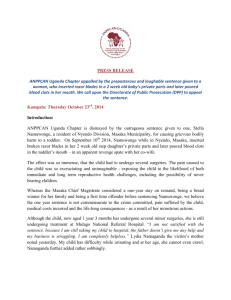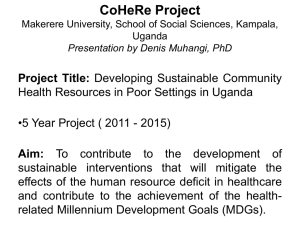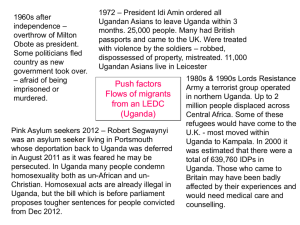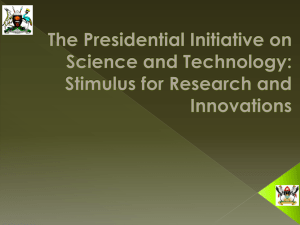Substance abuse problems in Uganda-20111005
advertisement
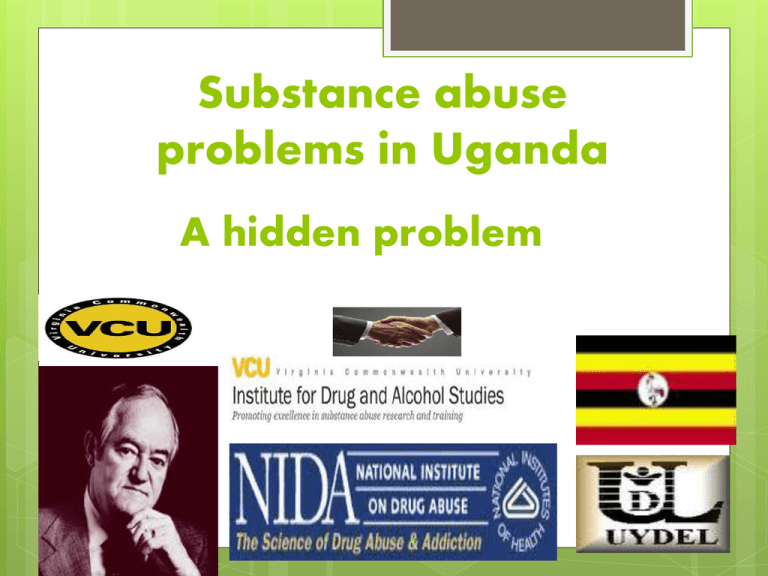
Substance abuse problems in Uganda A hidden problem Vital issues My role in the country UYDEL work National vital statistics Children under 18 years constitute 57.4% of Uganda’s 31 million people. Of Uganda’s 31 percent under the poverty threshold, 62% are children. number of orphans 2.43 million in 2010. HIV prevalence in Uganda is 6.5 %. 75 % of Ugandans live in poor quality houses, lack basic utilities such as water and sanitation. overall literacy rate among males of 76 % compared to females at 63%. high fertility rate of 6.9 % per woman has resulted into a high population growth rate of 3.2 percent Extent and Cost of Drug Abuse Alcohol is number one Sedatives, cannabis, Inhalants Opiates, synthetic narcotic analgesics and Hallucinogens. Increasing lack of discipline in a number of urban youth, violence,poverty,crime, accidents Other Drugs Increased Use Police reported that in 2009, 2,274 arrests made compared to 2,542 in 2008. In 2008-9 over 54 Ugandans had been arrested outside and 38 convicted to death in China. Other from various countries from India, Kenyans Nigerian, Pakistanis and Tanzanians in Uganda. Increase is attributed to unemployment, social upheavals, family disruptions, drop-outs from school. Increased production and trafficking, availability of the drug. Inadequate laws and weak border controls. Association with poverty, road accidents and HIV/AIDs The 5th major cause of poverty in Uganda. Road accidents have tripled in the last 5 years and mostly affected young people. Unprotected and high risk sexual behavior and teenage pregnancies are associated with HIV/AIDS. Food shortage/famine because young people spend more time drinking, less time in the fields. Domestic violence increases and compromises power relations in homes. Responses to drug abuse • • • • • Uganda does not have an effective law, though one has been on the shelves since 2005. The National Drug Authority Act 2000 is weak and comprehensive. NGO with limited capacity operates in major urban centers and impact difficult to measure. Active NGOs have been UYDEL, Serenity a decline in NGOs due to limited funding, Drug education is incorporated in schools. Treatment and Rehabilitation • 12 specialized facilities. • 25% mental cases is due to drug abuse. • Different levels of facilitation, border porous unmanned and manpower affect joint fight in the East African region . • Networking among NGOs is steal weak, Work to reduce alcohol and drug abuse is supported by IOGT-NTO and Mentor Foundation . UN Conventions Substances not under international control Khat, which is not currently under international control, continues to be cultivated in Uganda. Although khat consumption is associated with health risks and may have detrimental social consequences, the prohibition of khat is yet to be effected Banned by US and In Europe. Need to carry out 1st Accurate assessment of prevalence rates Training of staff in the region Advocacy for Strengthening National Drug control Support NGOs efforts to increase prevention Programs targeting young people Dissemination of good practices and Information. Factors escalating the use of alcohol High alcohol content Packing small Cheap Advertising poor law enforcement (place, time and age) Develop alternatives like music/ sports Involve parents and communities Increase Awareness on drug abuse Reference Most Photos were from Google Images acknowlgded and do not belong to the author.


